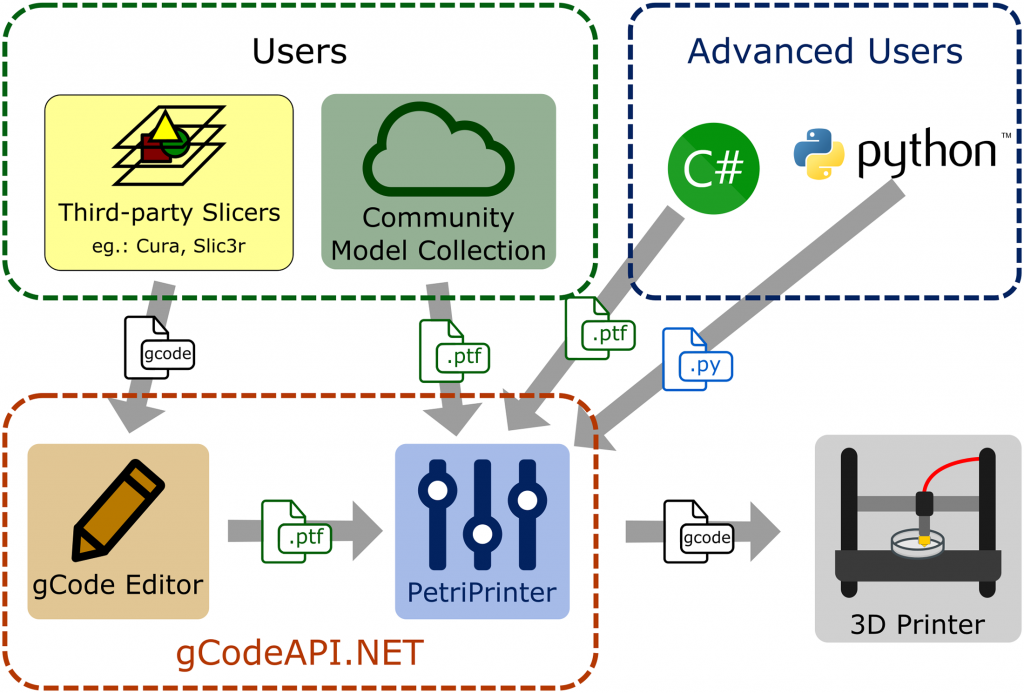Bioprinting is a growing, exciting field, with advancements being made toward the treatment of diseases and the eventual 3D printing of organs. Bioprinters are becoming more sophisticated and capable, but what about the software that is used with those 3D printers? In a paper entitled “Software tools for cell culture-related 3D printed structures,” a group of researchers points out that software lags behind on the bioprinting front. To address this problem, they developed a package of open source software tools specifically for bioprinting.
The software, according to the researchers, allows machine movements to be precisely specified using high level programming languages and easily distributed across a batch of tissue culture dishes. They note that while 3D printers can be easily modified to serve as bioprinters, bioprinting software has distinct requirements that differ from typical 3D printing software.
“Most importantly, bioengineering applications like cell printing or fabricating cell-scale environments often require well-defined, specialized motion patterns and an ability to reproduce it in parallel targets, like an array of culture dishes,” they explain. “Prescribing each machine movement by manually editing the low-level g-code sequence is laborious, error-prone and time-consuming. For this reason we developed a software package which can represent machine movements or g-code elements by simple functions of a high level programming language such as python or C#.”
They also created a graphic user interface called PetriPrinter that “distributes the programmatically defined printer movements into several culture dishes organized in a grid pattern.”
 To demonstrate the efficacy of the software, the researchers modified an Ultimaker 3D printer and printed simple PLA structures, in varying configurations, into petri dishes. To test the acute cytotoxicity of the PLA, they exposed two well-established cells lines – 3T3 fibroblasts and p31 mesothelioma tumor cells – to different amounts of PLA. After two days in culture, it was determined that the viability of the cells was not affected by the PLA. Long-term cytotoxicity was assessed as well, using a primary hippocampal neuron culture, and it was shown that after 7 days in vitro there was a cell death rate of less than 2.2.
To demonstrate the efficacy of the software, the researchers modified an Ultimaker 3D printer and printed simple PLA structures, in varying configurations, into petri dishes. To test the acute cytotoxicity of the PLA, they exposed two well-established cells lines – 3T3 fibroblasts and p31 mesothelioma tumor cells – to different amounts of PLA. After two days in culture, it was determined that the viability of the cells was not affected by the PLA. Long-term cytotoxicity was assessed as well, using a primary hippocampal neuron culture, and it was shown that after 7 days in vitro there was a cell death rate of less than 2.2.
The researchers’ open source software can be found on GitHub. The hope is that the software can enable scientists to more effectively carry out bioprinting experiments using even standard FFF 3D printers (with some modifications). It’s an exciting fact that expensive bioprinting equipment isn’t always necessary to conduct serious research, as long as you have enough know-how to modify a regular 3D printer to print biological material. Software may have been a stumbling block, but with this study, the researchers have made available a tool to make research more effective, without it being more expensive.
“To effectively transfer 3D printing know-how, some uniformization—a common language—is required,” the researchers conclude. “Our approach can represent a variety of objects by sufficient detail and precision, yet in a conceptionally clearer form than a sequence of machine-specific low-level movement commands. We hope that this platform will thus facilitate both the distribution as well as the development of new, experiment-specific devices or in vitro cell technologies.”
Authors of the paper include Marton Gulyas, Miklos Csiszer, Elod Mehes and Andras Czirok.
Discuss this and other 3D printing topics at 3DPrintBoard.com, or share your thoughts below.
Subscribe to Our Email Newsletter
Stay up-to-date on all the latest news from the 3D printing industry and receive information and offers from third party vendors.
Print Services
Upload your 3D Models and get them printed quickly and efficiently.
You May Also Like
3D Printing News Briefs, July 2, 2025: Copper Alloys, Defense Manufacturing, & More
We’re starting off with metals in today’s 3D Printing News Briefs, as Farsoon has unveiled a large-scale AM solution for copper alloys, and Meltio used its wire-laser metal solution to...
Etsy Design Rule Change Reduces Selection of 3D Printed Goods
Online marketplace Etsy has implemented a rule change requiring all 3D printed goods on the site to be original designs. The update to the site’s Creativity Standards states, ¨Items produced using...
Siraya Tech Introduces New Elastomer 3D Printing Materials, Including Foaming TPU
California company Siraya Tech, founded in 2019 with a focus on material science, customer focus, and agility, develops high-quality 3D printing materials that meet the needs of creators, hobbyists, and...
3D Printing News Briefs, April 12, 2025: RAPID Roundup
The news from last week’s RAPID+TCT in Detroit just keeps on coming! That’s why today’s 3D Printing News Briefs is another RAPID Roundup of more exciting announcements from the trade...



































